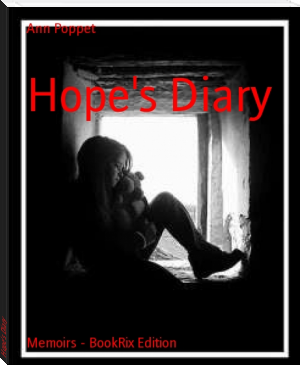Diary 2 by DeYtH Banger (best time to read books .txt) 📖

- Author: DeYtH Banger
Book online «Diary 2 by DeYtH Banger (best time to read books .txt) 📖». Author DeYtH Banger
Science
What makes red algae so different and why should we care?July 17, 2017

Porphyra clinging to rocks in Germany's Heligoland. It thrives in the harsh habitat of the intertidal zone, where it is exposed to fluctuating temperatures, high UV radiation, severe salt stress, and desiccation. Credit: Gabriele Kothe-Heinrich
The red algae called Porphyra and its ancestors have thrived for millions of years in the harsh habitat of the intertidal zone—exposed to fluctuating temperatures, high UV radiation, severe salt stress, and desiccation.
Red algae comprise some of the oldest non-bacterial photosynthetic organisms on Earth, and one of the most-ancient of all multicellular lineages. They are also fundamentally integrated into human culture and economics around the globe. Some red algae play a major role in building coral reefs while others serve as "seaweed" foods that are integral to various societies. Porphyra is included in salads (as are related genera of algae), is called "nori" in Japan, where it is used to wrap sushi, and "laver" in Wales, where it is a traditional and nutritious food ingredient.
Despite Porphyra's ecological, evolutionary, and commercial importance, there is still relatively little known about its molecular genetics and physiology.
That's why a team of plant scientists, including Carnegie's Arthur Grossman, sequenced and analyzed the complete genome of the red algae Porphyra umbilicalis. The genetic makeup of this extraordinarily hardy organism has provided researchers with a better understanding of red algal evolution and the ways in which these organisms cope with their brutal intertidal habitat.
Their findings are published by Proceedings of the National Academy of Sciences.

Porphyra is a food source in many cultures. It is called "nori" in Japan, where it is used to wrap sushi, and "laver" in Wales, where it is a traditional food ingredient. Credit: Carnegie Institution for Science
The team's analysis showed that Porphyra and other red algae have minimal structural elements that make up their cellular cytoskeletons as compared to other types of multicellular organisms. This may explain why the multicellular red algae tend to be "small" in stature.
Likewise, the team found genes for cellular processes that help Porphyra and its ancestors survive under extreme duress—including "sunscreen"-like compounds for protection from UV radiation and other compounds that allow them to withstand desiccating conditions, in addition to various proteins that ameliorate the potentially toxic consequences of absorbing strong sunlight. Furthermore, the extremely resilient, flexible walls of Porphyra cells allow them to dramatically change their volume as they lose water when they are baking in the sun and drying in the winds, and to withstand the forces of beating waves.
"The information we gleaned from the Porphyra genome shows us just how different red algae are," Grossman explained. "But it is also interesting to note that organisms evolutionarily related to the red algae have had profound impacts on human health and marine ecosystems."
For example, one group of organisms that evolved from the red algae, the apicomplexans, is non-photosynthetic and includes the plasmodium parasites that cause malaria. Another algal group that evolved from the red algae, the dinoflagellates, is responsible for toxic red tides, but is also the provider of nutrients that sustain corals, which serve as the foundation of reefs (which are homes for numerous animals).
As Grossman states, "As we learn more about the different algal groups and their evolutionary histories, we are learning more about the biotic pillars that continue to be a major foundation for sustaining and shaping life on our planet."
Source: Phys.org
These hormones may make breast cancer act like stem cellsby Jeff Sossamon-U. Missouri
New research links natural and synthetic progestins and the production of specialized cancer cells that act like stem cells in the body.
“These cells greatly increase the likelihood of resistance to therapies and the risk for metastasis.”
The findings could help scientists target these rare cells that proliferate in breast cancers and metastasize elsewhere, and may help clinicians identify immunotherapies to combat the spread of the disease.
Hormone replacement therapies—medications containing female hormones that substitute those no longer produced by the body—are often prescribed to reduce the effects of menopausal symptoms in women. Previous research has indicated that women who take hormone replacement therapies have a higher incidence of breast cancer.
“In previous studies, we have shown that both natural and synthetic progestins accelerate the development of breast cancer and increase their metastasis to lymph nodes,” says Salman Hyder, a professor of biomedical sciences in the College of Veterinary Medicine and the Dalton Cardiovascular Research Center at the University of Missouri.
“Our laboratory is committed to identifying the cell mechanisms that bring about increased breast cancer risks. Recently, our research focused on special cells—which are called ‘cancer stem cell-like cells’—that induce aggressive tumor growth, metastasis, and cancer recurrence.”
In a series of tests, the team used hormone-responsive human breast cancer cells to examine the effects of progestin on the cell markers typically found in breast cancers. Both natural and synthetic progestins significantly increased protein expression of CD44, a molecule involved in cell proliferation, cell communication, and migration.
Additionally, the presence of progestins caused these components to behave like cancer stem cell-like cells.
These rare cells are a small population of cells that—acting like normal stem cells—are self-renewing, create identical copies of themselves, and proliferate exponentially. Further testing showed that the rare subset of cancer cells actually was enriched by progestin.
“The findings show that exposure to natural and synthetic progestins leads to the development of these cancer stem-cell like cells,” Hyder says.
“These cells greatly increase the likelihood of resistance to therapies and the risk for metastasis. Our findings also suggest that clinicians may be able to combat the progestin-dependent tumor growth through immunotherapy.”
Did we evolve insomnia as a way to survive?by Robin Smith-Duke

A sound night’s sleep grows more elusive as people get older, but what some call insomnia may actually be an age-old survival mechanism.
For people who live in groups, differences in sleep patterns commonly associated with age help ensure that at least one person is awake at all times, a study of modern hunter-gatherers in Tanzania shows.
The findings suggest that mismatched sleep schedules and restless nights may be an evolutionary leftover from a time many, many years ago, when a lion lurking in the shadows might try to eat you at 2 am.
“The idea that there’s a benefit to living with grandparents has been around for a while, but this study extends that idea to vigilance during nighttime sleep,” says coauthor David Samson, who was a postdoctoral fellow at Duke University at the time of the study.

Hadza women walking in northern Tanzania. (Credit: Alyssa Crittenden, U. Nevada, Las Vegas)
The Hadza people of northern Tanzania live by hunting and gathering their food, following the rhythms of day and night just as humans did for hundreds of thousands of years before people started growing crops and herding livestock.
They live and sleep in groups of 20 to 30 people. During the day, men and women go their separate ways to forage for tubers, berries, honey, and meat in the savanna woodlands near Tanzania’s Lake Eyasi and surrounding areas. Then each night they reunite in the same place, where young and old alike sleep outside next to their hearth, or together in huts made of woven grass and branches.
“They are as modern as you and me. But they do tell an important part of the human evolutionary story because they live a lifestyle that is the most similar to our hunting and gathering past,” says coauthor Alyssa Crittenden, associate professor of anthropology at the University of Nevada, Las Vegas.
“They sleep on the ground, and have no synthetic lighting or controlled climate—traits that characterized the ancestral sleeping environment for early humans.”
For the study, 33 healthy men and women aged 20 to 60 agreed to wear a small watch-like device on their wrists for 20 days, that recorded their nighttime movements from one minute to the next.
Hadza sleep patterns were rarely in sync. On average, participants went to bed shortly after 10 pm and woke up around 7 am But, some tended to retire as early as 8 pm and wake up by 6 am, and others stayed up past 11 pm and snoozed until after 8 am.
In between, they roused from slumber several times during the night, tossing and turning or getting up to smoke, tend to a crying baby, or relieve themselves before nodding off again.
As a result, moments when everyone was out cold at once were rare. Out of more than 220 total hours of observation, the researchers were surprised to find only 18 minutes when all adults were sound asleep simultaneously. On average, more than a third of the group was alert, or dozing very lightly, at any given time.
“And that’s just out of the healthy adults; it doesn’t include children, or people who were injured or sick,” says Samson, now an assistant professor of anthropology at the University of Toronto, Mississauga.
Yet participants didn’t complain of sleep problems.
The findings may help explain why Hadza generally don’t post sentinels to keep watch throughout the night—they don’t need to. Their natural variation in sleep patterns, coupled with light or restless sleep in older adults, is enough to ensure that at least one person is on guard at all times.
“Maybe some of the medical issues we have today could be explained not as disorders, but as a relic of an evolutionary





Comments (0)